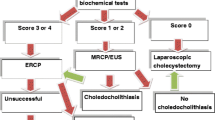Abstract
Background
Although intraoperative cholangiography (IOC) is a widely used method for detecting common bile duct stones (CBDS), its accuracy has not been fully evaluated in large nonselected patient samples. The purpose of this study was to assess the sensitivity, specificity and predictive value of dynamic IOC regarding its ability to diagnose CBDS in a population-based setting, and to assess the morbidity associated with the investigation.
Methods
All patients operated on for gallstone disease between 2003 and 2005 in the county of Uppsala in Sweden, a county with a population of 302,000 in December 2004, were registered prospectively. The outcome of cholangiography was validated against the postoperative clinical course.
Results
1171 patients were registered, and among these IOC was performed in 1117 patients (95%). Common bile duct stones were found in 134 patients (11%). One perforation of the common bile duct caused by the IOC catheter was recorded. Sensitivity was 97%, specificity 99%, negative predictive value 99%, positive predictive value 95%, and overall accuracy 99%. In 7 of the 134 cases where IOC indicated CBDS, no stones could be verified on exploration. In 4 of the 979 cases where IOC was normal, the clinical course indicated overlooked CBDS.
Conclusion
Intraoperative cholangiography is a safe and accurate method for detecting common bile duct stones.

Similar content being viewed by others
Abbreviations
- CBD:
-
Common bile duct
- CBDS:
-
Common bile duct stones
- IOC:
-
Intraoperative cholangiography
- MRI:
-
Magnetic resonance imaging
- ERCP:
-
Endoscopic retrograde cholangiopancreatography
- PTC:
-
Percutaneous transhepatic cholangiography
- MRCP:
-
Magnetic resonance cholangiopancreatography
- ALP:
-
Alkaline phosphatase
References
Machi J, Tateishi T, Oishi AJ, Furumoto NL, Oishi RH, Uchida S, Sigel B (1999) Laparoscopic ultrasonography versus operative cholangiography during laparoscopic cholecystectomy: review of the literature and a comparison with open intraoperative ultrasonography. J Am Coll Surg 188:360–367
Metcalfe MS, Ong T, Bruening MH, Iswariah H, Wemyss-Holden SA, Maddern GJ (2004) Is laparoscopic intraoperative cholangiogram a matter of routine? Am J Surg 187:475–481
Snow LL, Weinstein LS, Hannon JK, Lane DR (2001) Evaluation of operative cholangiography in 2043 patients undergoing laparoscopic cholecystectomy: a case for the selective operative cholangiogram. Surg Endosc 15:14–20
Mirizzi (1934) PL La Cholanciografia Durante las operaciones de las vias biliares Bol Soc Chir Buenos Aires 16:1133
Beldi G, Styner M, Schindera S, Inderbitzin D, Candinas D (2006) Intraoperative three-dimensional fluoroscopic cholangiography. Hepatogastroenterology 53:157–159
Statistict Sweden Available at: http://www.scb.se/ January 2007; Accessed 30 January 2002
Manigmant program for gallstone disease in Uppsala County, Sweden. Available at http://www.uas.se/templates/page____29650.aspx. 2005; Accessed 19 September 2007
MacFadyen BV (2006) Intraoperative cholangiography: past, present, and future. Surg Endosc 2:436–440
Birth M, Ehlers KU, Delinikolas K, Weiser HF (1998) Prospective randomized comparison of laparoscopic ultrasonography using a flexible-tip ultrasound probe and intraoperative dynamic cholangiography during laparoscopic cholecystectomy. Surg Endosc 12:30–36
Siperstein A, Pearl J, Macho J, Hansen P, Gitomirsky A, Rogers S (1999) Comparison of laparoscopic ultrasonography and fluorocholangiography in 300 patients undergoing laparoscopic cholecystectomy. Surg Endosc 13:113–117
Thompson DM, Arregui ME, Tetik C, Madden MT, Wegener M (1998) A comparison of laparoscopic ultrasound with digital fluorocholangiography for detecting choledocholithiasis during laparoscopic cholecystectomy. Surg Endosc 12:929–932
Barteau JA, Castro D, Arregui ME, Tetik C (1995) A comparison of intraoperative ultrasound versus cholangiography in the evaluation of the common bile duct during laparoscopic cholecystectomy. Surg Endosc 9:490–496
Varadarajulu S, Eloubeidi MA, Wilcox CM, Hawes RH, Cotton PB (2006) Do all patients with abnormal intraoperative cholangiogram merit endoscopic retrograde cholangiopancreatography? Surg Endosc 20:801–805
Author information
Authors and Affiliations
Corresponding author
Rights and permissions
About this article
Cite this article
Videhult, P., Sandblom, G. & Rasmussen, I.C. How reliable is intraoperative cholangiography as a method for detecting common bile duct stones?. Surg Endosc 23, 304–312 (2009). https://doi.org/10.1007/s00464-008-9883-2
Received:
Revised:
Accepted:
Published:
Issue Date:
DOI: https://doi.org/10.1007/s00464-008-9883-2




